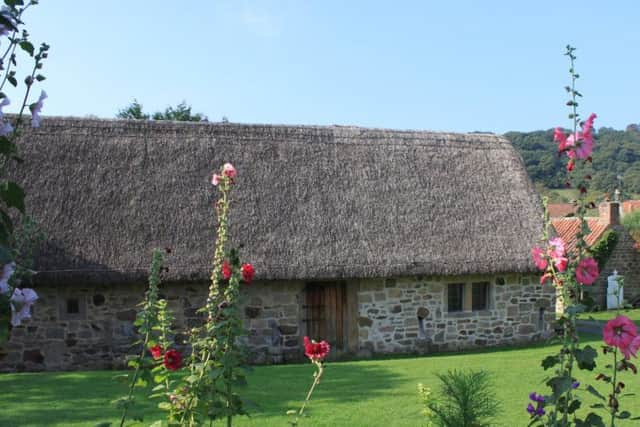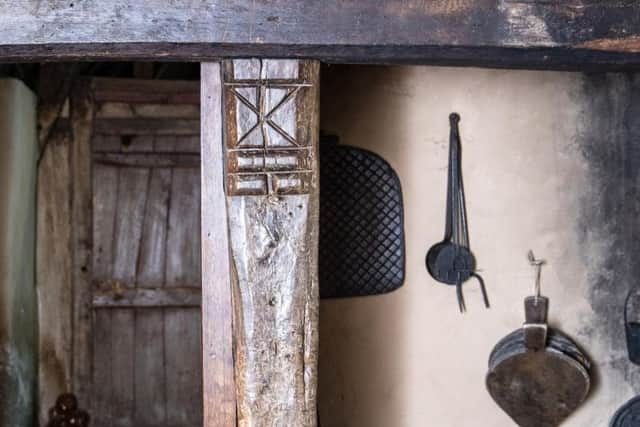Why poor, elderly women were accused of witchcraft - Ryedale Folk Museum hopes to challenge stereotypes this Halloween
Inscribed with the cross of St Andrew, they were thought to protect a house from the influence of supposed witches, believed to prevent them from entering through the chimney.
Fewer than 20 of the posts are said to remain in existence today and they are almost exclusive to North East Yorkshire, with Ryedale Folk Museum home to three, including one in situ
Advertisement
Hide AdAdvertisement
Hide Adin a thatched cottage brought to the site from the moorland village of Danby.


The Yorkshire Witches: Mary Bateman, Mary Pannal and Mother ShiptonAs Halloween approaches, the museum, which tells tales of life in the North York Moors from prehistoric times right through to the 20th century, hopes to engage people
with the stories and myths around them and challenge stereotyping around men and women accused of witchcraft.
“Those accused of witchcraft were often the most vulnerable within society,” explains education officer Sarah Winter. “[They were] desperately poor women, elderly or widowed, lacking the protection that a husband could provide. We feel that, particularly at this time of year, museums can shed light on theses stories.”
Advertisement
Hide AdAdvertisement
Hide Ad“Older women were under great pressure to be ‘useful’, earning their keep through chores,” museum staff elaborate. “The witch’s supposed means of transportation, the broomstick, is a reminder of a woman’s domestic place in society, her role sweeping the house.


“During a new mother’s period of ‘lying in’, it would often be these older women of the village who would support with the care of the new baby – and get the blame if things went wrong.
And things often went wrong during periods of high infant mortality, exacerbated by failed harvests and limited medical interventions.”
While many will put on pointy hats and black cloaks to dress as ‘‘witches’’ this Halloween, museum volunteer Clare Almond’s costume will be decidedly lacking in fake warts and instead feature traditional Tudor or Stuart garb.
Advertisement
Hide AdAdvertisement
Hide AdManuscript telling story of 17th century Yorkshire witchcraft trial to go on saleSince joining the team, she has researched the lives of those accused of witchcraft. Across Europe, the museum says the gender imbalance was stark, with women believed to be more vulnerable to ‘‘succumbing to the devil’’ due to a perceived lack of intellect, and making up around 80 per cent of those accused of witchcraft.
“The deeper she delved, the more Clare realised that the women she now represents were a significant but easily-overlooked group, their contribution to rural life and social history too often forgotten,” says events coordinator Rosie Goodwin. "A fascination with stereotypes in popular culture can lead to crucial stories from history being neglected.”
With its Magic or Medicine? event tomorrow, the museum, in Hutton-le-Hole hopes to get visitors exploring beyond the stereotypes to see another side to ‘‘witches’’, while also learning about beliefs, superstitions and the healing properties of everyday remedies.
It will host a ‘‘witch trial’’ in its Manor House, with people invited to the sessions at 11.30am and 1.30pm to have their say on the witch’s fate. “It’s easy to get swept up with the stereotypes at Halloween,” says Rosie. “We’d love our audiences to reconsider their views once they’ve met our witch. The official punishments was the ducking stool, but onlookers can help decide her fate at the trials – so we’re hoping they will be kind.”
Shoppers would rather spend money on Halloween than face the real horrors in Parliament - Ros SnowdonFor more information, visit www.ryedalefolkmuseum.co.uk